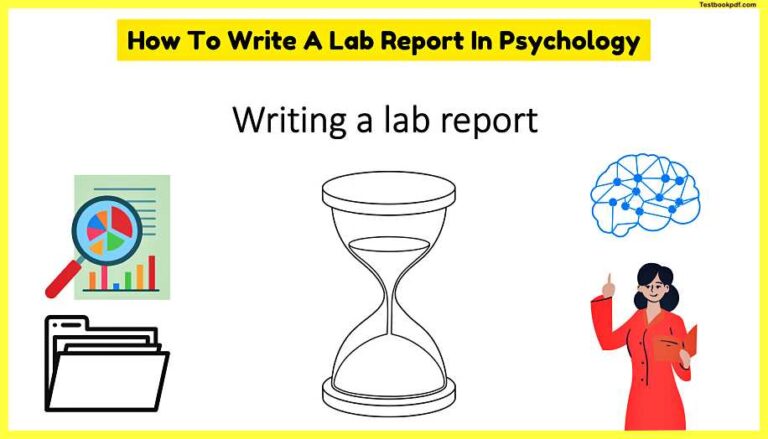How To Write A Lab Report In Psychology
In this article I’m going to be talking about How To Write A Lab Report In Psychology, there are lots of rules and guidelines and I won’t be able to cover all of these in just one article but my plan for the article is to give you a good overview of the key areas of a lab report all of the other little skills and details.
You can pick up along the way with practice but when you’re writing a lab report for an assignment the majority of the marks will usually come from what you write in each section and whether you meet the overall criteria for each section.
So when you’re starting out focus on the structure and include the relevant information in each section hopefully from the article today you’ll get a good idea about how to do that.
Sections of a Research Report
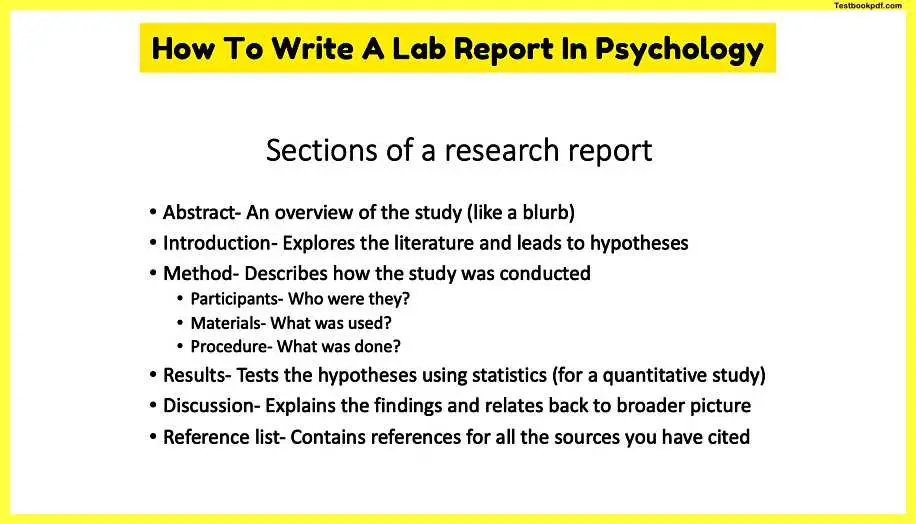
There are six main sections of a lab report.
- The first section that the reader will see is the abstract this is like an overview of this study so you can think of it as being a bit like a blurb of a book except, unlike a blurb, there won’t be any suspense so you’ll be telling the reader upfront what all of the key details of the study.
- The next section is the introduction section this is where you explore the Literature and provide justifications for your hypotheses.
- The method section describes how the study was conducted and this is usually made up of three subsections of participants’ materials and procedure after the method section is the results section.
- This is where you’ll test your hypotheses using statistics.
- The discussion section will explain those findings in Moore’s plain language so you’ll be explaining what the results were and relating those back to the broader picture of the literature.
- Then finally your lab report will contain a reference list which is all of the sources that you have cited throughout.
So we can think of a lab report as being a bit like an hourglass everything should flow through logically from beginning to end
And we can also use the hourglass metaphor to demonstrate the structure of the lab report and the focus of each section so this is what I’m going to be going through today.
Introduction Section
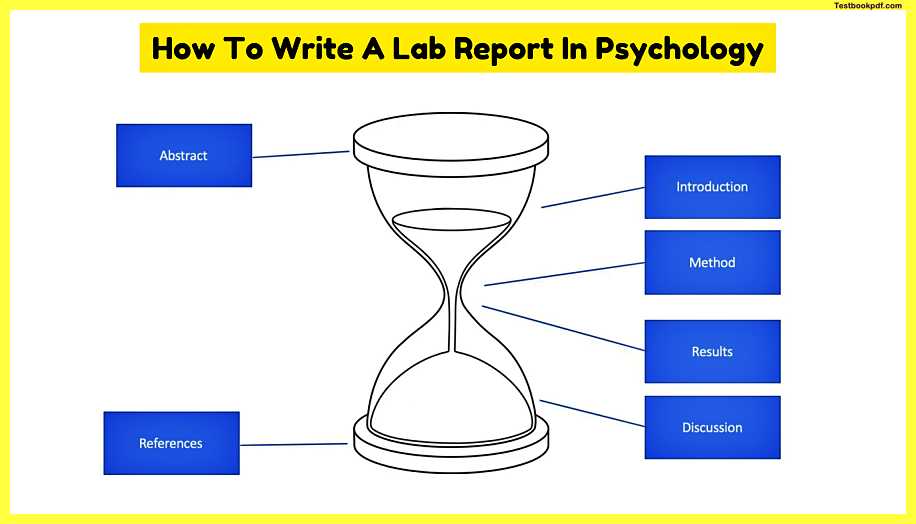
If we zoom in on this introduction we can see that it forms a bit of an inverted triangle structure so we start with a broad introduction move to the body paragraphs and then finish with the aims and hypotheses.
Broad Introduction
The broad introduction should just be around about one paragraph and this is difficult to write because it should be broad but not overly broad so one way that you can avoid making it overly broad is to not make any claims that can’t be supported with evidence so saying things like since humans evolved or it is a fact of human nature that there’s also no need to introduce all of the concepts all at once but the purpose of the broad introduction is just to start framing the topic so this is one area where an introduction section although it might look like an essay in some ways it isn’t structured in the same way as an essay.
In an essay, the introduction paragraph should start to capture all of the main arguments that you’ll be making whereas in a lab report you just need to start introducing the general idea of the research you should also make it clear in this opening paragraph why the topic is important and this will make the reader want to keep reading so you can think about things like what is the real world relevance of this particular topic.
For example, if your research was on a topic such as stereotypes then in this broad introduction you might like to mention the prevalence of stereotypes or the impact that stereotypes have on mental health and use citations to back up your claims.
You can see from this how the broad but not too broad idea can be a difficult balance to strike so sometimes when writing it’s actually easier to start with writing the body paragraphs or even the methods section which I’ll talk about later and then come back to writing the first paragraph when you’re feeling a bit more confident or have a stronger grasp on the material sometimes it also helps to just get some words down on the page before you try to come up with that perfect opening sentence.
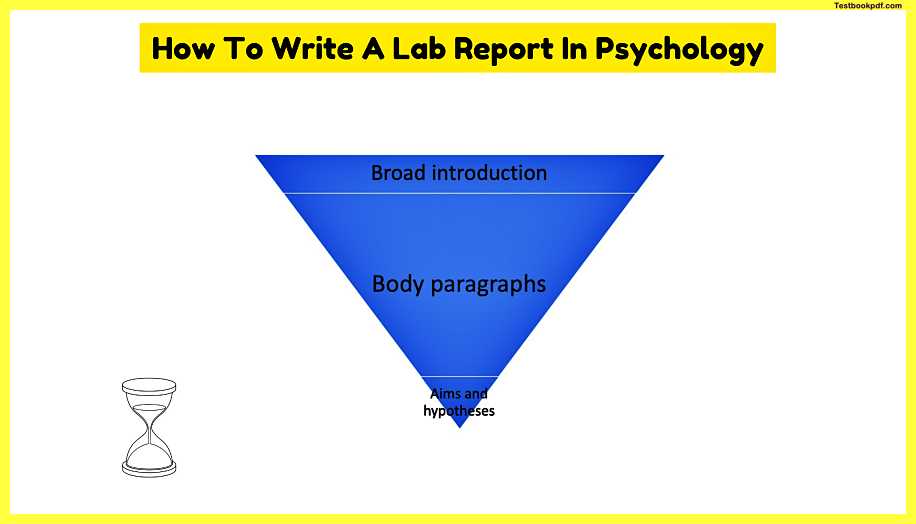
Body Paragraphs
The body paragraphs are the biggest section of the introduction and the purpose of these paragraphs is to explore past research on the topic so you should define concepts as soon as possible after you introduce them so that the reader knows as soon as you start talking about something, what it is that you’re actually talking about you should also ensure that points flow logically from one to the next so paying close attention to the structure or the order of your paragraphs will be really important here.
You should also avoid including unnecessary information such as details about the methods of past research that aren’t actually relevant to the arguments that you’re building the number of paragraphs that you write in this section will depend on the topic and also on the word limit so there’s no universal rule for this but overall the aim of this section is to provide justifications for your hypotheses.
When you’re writing the body paragraphs it’s important that you structure the paragraphs well so that your argument is clear and explicit and really stands out to the reader so use topic sentences.
The first sentence of each paragraph should clarify what it is that you’re going to be arguing and then the following sentences of each paragraph should unpack and explore those ideas further.
You can see from this overall structure that after we’ve started really broad with the broad introduction the body paragraphs will start to get more and more specific.
Aims and Hypotheses
The aims and hypotheses should all be presented at the end in the final paragraph of the introduction this should just be in one single paragraph and it doesn’t need a subheading.
Hypotheses should be directional and operationalized so a clear statement about what it is that you’re expecting the results will show and these should be so well justified from your body paragraphs that the reader should basically be able to guess what it is that you’re going to hypothesize before they even read that final paragraph.
Method Section
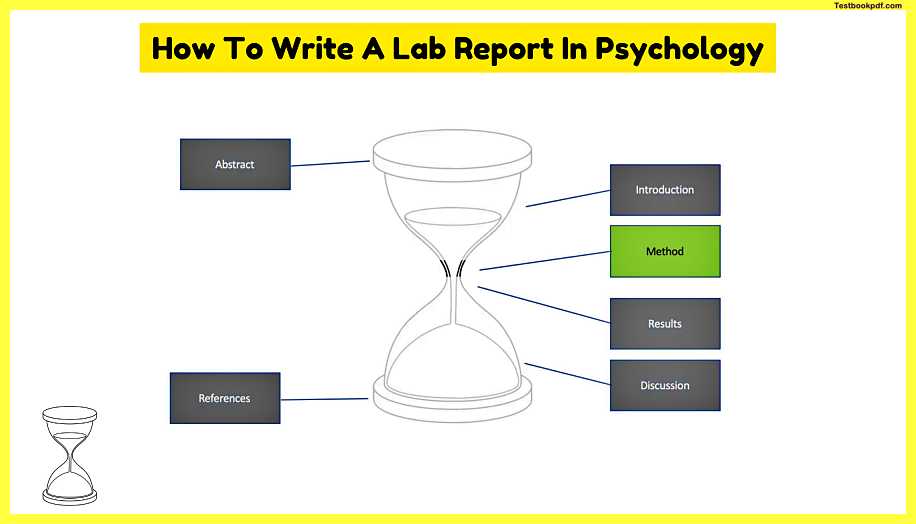
The method section follows directly after the introduction and it doesn’t begin on a new page.
There are 3 main parts of the method section.
- Participants
- Materials
- Procedure
Participants Section
You will probably need to include details such as the number of participants and how they were selected so perhaps whether they participated in the study as part of their course that they were doing and also other relevant demographic variables so often age and gender is irrelevant sometimes ethnicity sometimes education level it really depends on the exact topic of research as to what will be relevant but here and in the method section more generally you want to be describing the method in enough detail that a future researcher will be able to replicate your study.
Material Section
For most of the reports, you write the material section would just be describing the questionnaire that was given to participants so the best approach to this is to describe each measure in its own paragraph.
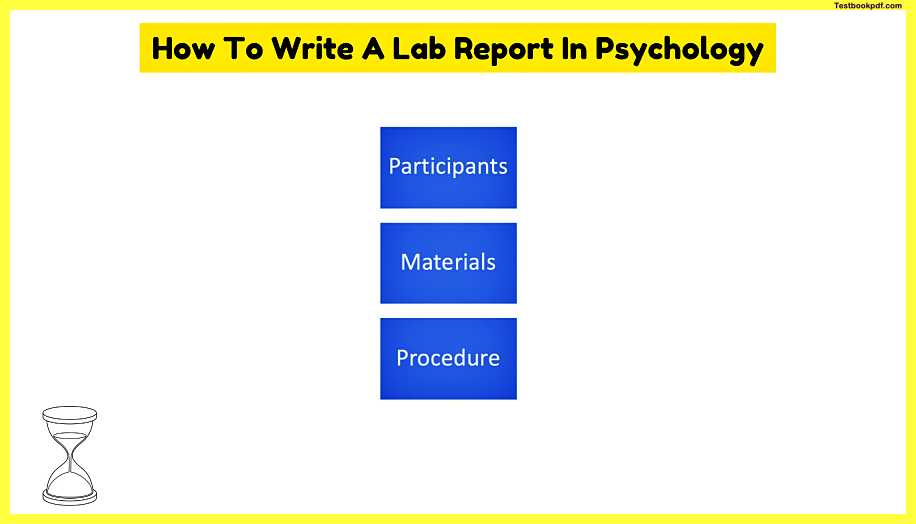
These paragraphs mentioned the name of the scale and the correct citation of what it was intended to measure.
- How many items there were and whether there were any sub-scales used?
- How the test was scored or what high scores on that scale indicate.
- Give an example item or two in order to really illustrate to the reader exactly what the study did
In units beyond the first year it is also a good idea to mention the psychometric properties of the scale this means the evidence that the scale is reliable and valid and you can get this from the original article that discolors published in or really any other article that has used that scale since.
When writing up the material sections try to be really descriptive so rather than just saying something like the feminist social identity scale was used to measure feminist identity which doesn’t really tell us much more beyond the name of the scale you can say something more like the feminist social identity scale was used to measure the extent to which participants align their identities with the feminist social group with feminist attitudes and engage in feminist hype behaviors so by adding in these extra details we’re giving the reader more information than they would be able to get from just that simple name of the scale.
Procedure Section
In the procedure section you’ll be talking about how the study was conducted so you’ll be mentioning things like whether it was an online study or whether it was conducted in a lab or perhaps whether it was a pencil paper survey you can mention things like whether there were any time limits or otherwise how long the study approximately took participants to complete you can also mention here whether there was any deception of the participants involved and how this was done so what was the cover story you told to participants and you could also briefly touch on some of the ways that you addressed the ethical considerations as well so things like how participants provided informed consent or whether they had the right to withdraw at any point for example.
Results Section
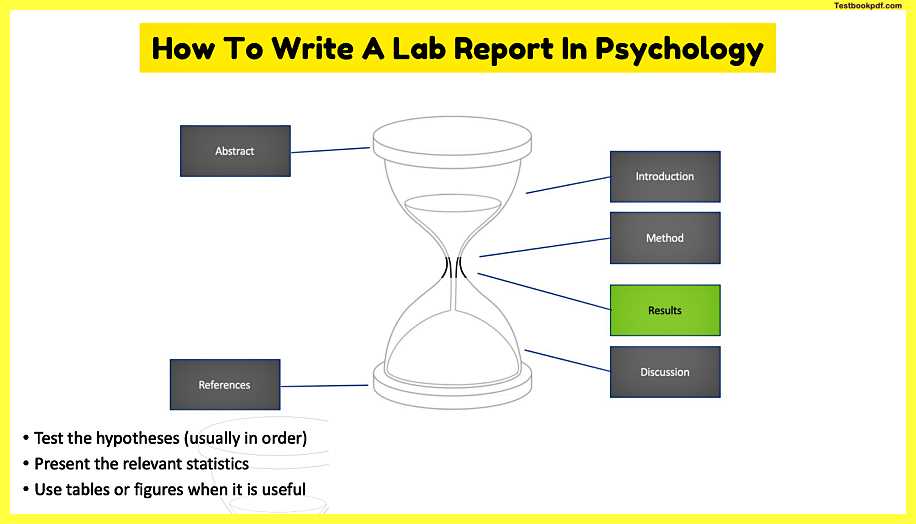
The results are what we got using those measures and the procedure with those participants that we’ve described in the method section, The results section follows directly after the method and again it doesn’t begin on a new page.
The results section basically tells the reader how the data was analyzed so for example you might report on things like correlations between different variables or you might report on something like a t-test comparing whether group a and Group B differ on a particular measure.
What you will need to cover in the results section will really depend on what the data actually was and what analyses were required some things that you might like to keep in mind though when you’re writing your method section are things like not restating the hypotheses and not to begin interpreting the findings.
So if you restate your hypothesis you’re going to be using up a lot of words that could be put to better you particularly because you’ve already made your hypotheses clear in the introduction section.
So at most you can say things like as expected or contrary to expectations in your descriptions of the results and this gives the reader enough of an indication about whether the hypotheses were supported without you having to repeat the information or waste words.
In the results section, you can often use tables or figures to present the information when you’re thinking about using tables or figures something to keep in mind is that they should only be used when they make things easier for the reader not just because it’ll make it easier for you to stick to the word limit you can think of tables and figures like illustrations in a book they can add extra detail but really they’re just there to supplement what you say you still need to be the one that tells the story of the results in text.
There are also a lot of specific rules about the formatting of tables and figures which I won’t go into here but I’ll mention some other resources at the end of the article that you can use.
Discussion Section
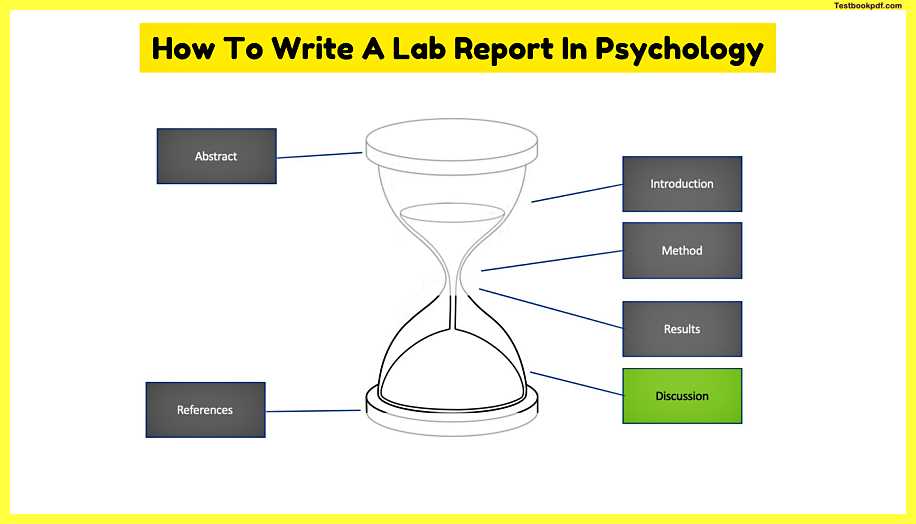
From the results section we then flow into the discussion and you can see from the discussion that this is really a mirror of what we’ve already covered in the introduction section and if we zoom into this pyramid shape this is the sort of thing that we’ll see so while in the introduction section we started broad and got more specific in the discussion section you’ll start specific and then get broad so you’ll begin by talking about your specific study and then you’ll widen the scope to considering issues such as what your study has contributed to the literature and wider society so go through each of these different components of the discussion now.
Brief Overview
In the first paragraph of the discussion section you should just give a very brief overview of what was found again you don’t need to repeat your hypotheses in full here it’ll use too many words and it will already have been cleared just from the results section that you’ve recently covered what your hypotheses were you’ll also be talking about them in more detail in the following paragraphs – so this opening paragraph can really just be a couple of sentences about what the overall aim of your study was and the general findings.
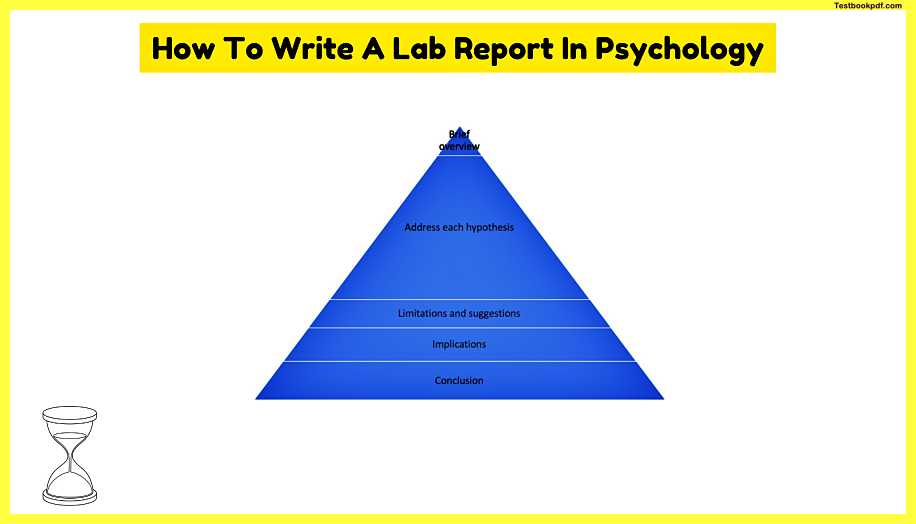
Addresses Each Hypothesis
The biggest section of the discussion addresses each of your hypotheses you don’t need to repeat the hypotheses in full but again you can just say things like as expected women were more likely to call themselves feminists compared to men.
So it’s important to address each hypothesis in its own paragraph so that you’ve got enough room to really unpack each of the findings in full.
For each paragraph, the easiest thing is to start by stating whether the hypothesis was supported or not in the following sentences you’ll link back to the literature so did the findings support past literature or not?
And then you’ll need to explain the finding so why might it have been the case that women were more likely to call themselves feminists compared to men could it be because they view the term more positively compared to men because it’s more socially acceptable for women to call themselves feminists whatever it is you need to bring in evidence to support the interpretation wherever possible if your hypothesis was not supported then you might need to go back to the literature and find other research to explain your findings once you have fully addressed the hypothesis.
You can move on to the next one and it’s a good idea to try to address each of your hypotheses in the same order throughout your entire lab report so the order in which you argue for them in the introduction should be the order in you present the hypotheses in that final paragraph of the introduction then the same order that you test the hypotheses in the results section and the same order that you unpack them in the discussion section.
Limitations and Research
Once you’ve addressed each hypothesis by linking it back to the literature and explaining your findings you’ll then need to consider the limitations of your research and provide some suggestions for future research a limitation is something about the design or the method of the study that could have had an impact on the results or the interpretation of the findings in this section it’s best two pictures one or two of the major limitations and spend the time explaining how they might have had an impact on this study again you’ll need to bring in any literature or evidence that you can use to support your claims.
Something you want to avoid is listing as many possible limitations as you can think of this really limits the room that you have to actually explain and unpack so it’s better to just pick one or two and to spend the time actually explaining those if you try to cover too many limitations it also gives the impression that the study was so flawed that it might not actually be useful.
You should then build off these limitations to provide specific suggestions for how future research could improve on the issue.
There are a few limitations that are commonly mentioned in undergrad assignments but should usually be avoided these are that there is a gender imbalance in the participants and that the participants were university students in most cases there will probably be no evidence that these factors actually impacted on the study so unless you’ve got some solid evidence it’s best to avoid these limitations.
Implication Section
The implication section is where the focus of the study widens out even further in this section you’ll be linking your findings back to how the research might be important in terms of its contribution to the literature but also what some of the real-world applications might be so perhaps your study might contribute to psychological interventions it might contribute to the development of policy or you know it might have some other impact on individuals day to day lives or well-being so this part is where you need to start thinking about the bigger picture of your study why is it important.
conclusion Section
This is just the final paragraph of your discussion and it doesn’t require any subheadings the conclusion section can be relatively brief and will just give an overview again about sort of what this study has accomplished and why it was important.
It’s okay to mention some of the limitations or suggestions for future research in the conclusion but you want to avoid finishing on those points remember that this conclusion will be the last thing that the reader will actually read so you want to make them feel good for having invested the time reading your report so if the very last thing that the reader reads is something about how the study was flawed or about what else needs to be done then it will give the impression that your study in and of itself might not have been particularly useful so you can mention the limitations in future research suggestions in the conclusion but try to end on a more positive point such as by touching on those implications again.
Abstract
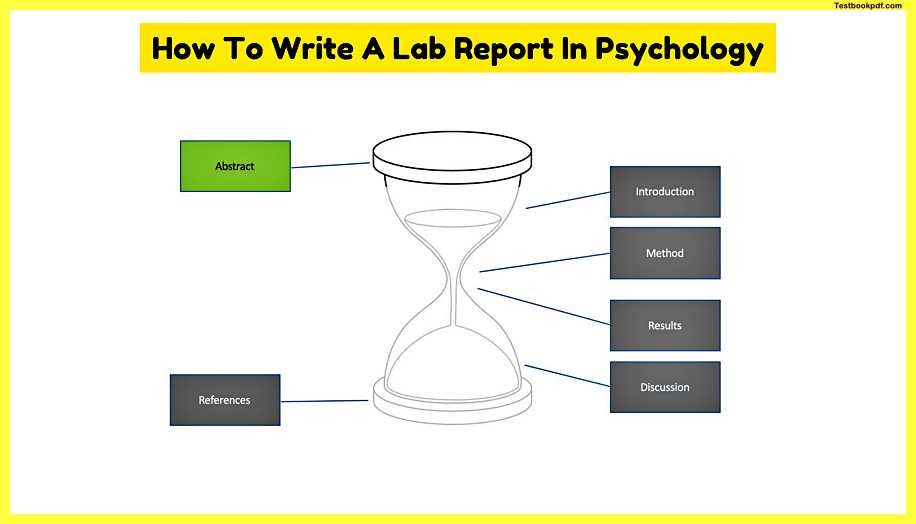
Going back to our hourglass you can see that the hourglass also has a top and a bottom these the top and the bottom don’t really contribute to the overall structure of the hourglass but they’re important to frame it.
So the abstract section while it’s the first thing that the reader will see will actually be the last thing that you write the abstract section should be no longer than 250 words and in a lot of assignments, it should be even shorter than that so use the word count of your assignment as a guide for how long the abstract should be.
An abstract section is a single paragraph that summarizes the contents of the paper so you’ll generally touch on the importance of the topic the aim of the research the general method and design the main findings and the overall conclusions that can be drawn from your study and when you’re starting to write the abstract section if you start with writing a sentence on each of those points it will give you a good place to start working with.
References
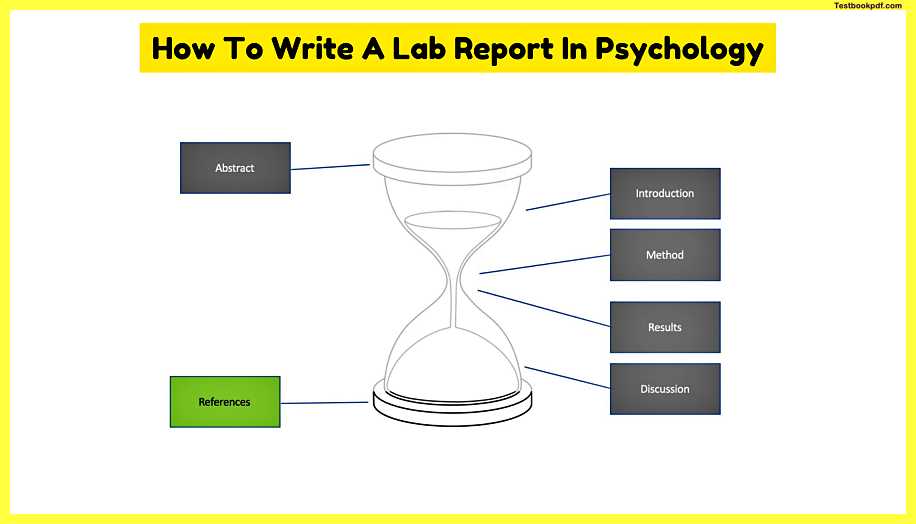
The reference list goes at the end of the report and this one does start on a new page it contains the references for all of the works that you have cited throughout the report and noting that you haven’t cited this is the difference between a reference list and a bibliography in a bibliography you would cite or reference everything that you have read regardless of whether or not you’ve cited it but in a reference list you only want to include things that have actually been cited throughout.
- As I mentioned there are still lots of things that I haven’t been able to cover in this short article so if you still have questions there are heaps of resources that are available to you one useful book is the text by Bruce Findlay called how to write psychology research reports and essays this book gives detailed information not just about basic formatting requirements but also about the structure and the sections of a lab report.
- Keep in mind though that the final book has not yet been updated to cover the APA seven rules at least at the time of writing this article.
- So it may be something that you want to access through the library for a little bit until it has been updated but by then it will definitely be worth purchasing.
- Another handy resource is the APA publication manual this manual contains in-depth information about formatting as well as writing style but it contains much less information about the sections of a lab report if you’re planning on going on and completing an undergrad degree in psychology and even a post-grad degree it will still be a worthwhile purchase.
- Most universities will also have their own materials that are available to you and there are also lots of free online resources including the APA style blog also remember that the teaching staff is there to help you as well so please make use of the discussion board attend your tutorials or collaborate sessions and get in touch with your tutor if you do have any questions.
- The important thing to remember is that writing a lab report is not going to come naturally to anyone it is a skill to learn and skill requires practice, so while you when you’re in these beginning stages of learning to write the lab report use your assignments of a way as a way of getting feedback and refining the skill don’t focus on the mark that you’re getting as with any skill it will get the easier time you’ll be writing many lab reports over the course of your degree and each one you should aim to be improving from the last so be patient with yourself and try to have as much fun as possible and as always reach out if there is anything that your teaching staff can do to help you.
Read also:-
- Attachment Psychology Paper 1 Pdf Download
- Essay Writing Tips for Psychology Students (Pdf Download)
- B.Ed Study Material: CCSU UNIVERSITY Project Files
- What Is A Box Plot In Statistics?
- What Is P Value For Statistical Significance
- The Normal Distribution and The 68-95-99.7 Rule
- AQA A-Level Psychology Paper 1 Memory Pdf Download
- AQA A-Level Psychology Paper 3 Schizophrenia (Pdf Download)
